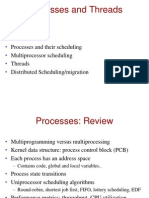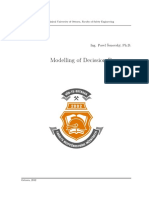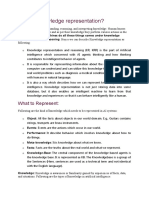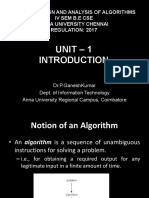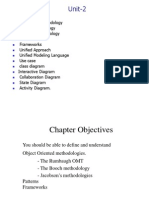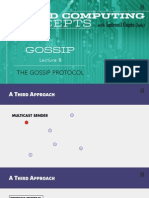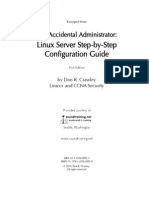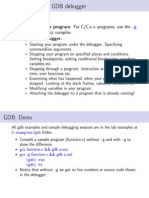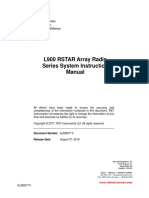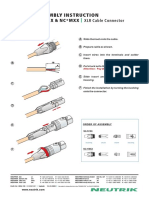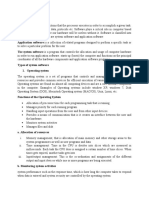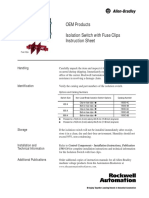CSE 421/521 - Operating Systems
Fall 2014
Lecture - IV
Threads
Tevfik Koar
University at Buffalo
September 4th, 2014
�Roadmap
Threads
Why do we need them?
Threads vs Processes
Threading Examples
Threading Implementation & Multi-threading Models
Other Threading Issues
Thread cancellation
Signal handling
Thread pools
Thread specific data
�Concurrent Programming
In certain cases, a single application may need to run
several tasks at the same time
1
1
3
4
concurrent
4
5
sequential
�Motivation
Increase the performance by running more than one
tasks at a time.
divide the program to n smaller pieces, and run it n times
faster using n processors
To cope with independent physical devices.
do not wait for a blocked device, perform other operations at
the background
�Serial vs Parallel
COUNTER 2
COUNTER
COUNTER 1
Please
�Divide and Compute
x1 + x2 + x3 + x4 + x5 + x6 + x7 + x8
How many operations with sequential programming?
7
Step
Step
Step
Step
Step
Step
Step
1:
2:
3:
4:
5:
6:
7:
x1
x1
x1
x1
x1
x1
x1
+
+
+
+
+
+
+
x2
x2
x2
x2
x2
x2
x2
+
+
+
+
+
+
x3
x3
x3
x3
x3
x3
+
+
+
+
+
x4
x4
x4
x4
x4
+
+
+
+
x5
x5 + x6
x5 + x6 + x7
x5 + x6 + x7 + x8
6
�Divide and Compute
x1 + x2 + x3 + x4 + x5 + x6 + x7 + x8
Step 1: parallelism = 4
Step 2: parallelism = 2
Step 3: parallelism = 1
�Gain from parallelism
In theory:
dividing a program into n smaller parts and running on n
processors results in n time speedup
In practice:
This is not true, due to
Communication costs
Dependencies between different program parts
Eg. the addition example can run only in log(n) time not 1/n
�Concurrent Programming
Implementation of concurrent tasks:
as separate programs
as a set of processes or threads created by a single program
Execution of concurrent tasks:
on a single processor (can be multiple cores)
Multithreaded programming
on several processors in close proximity
Parallel computing
on several processors distributed across a network
Distributed computing
�Why Threads?
In certain cases, a single application may need to run
several tasks at the same time
Creating a new process for each task is time consuming
Use a single process with multiple threads
faster
less overhead for creation, switching, and termination
share the same address space
10
�Threading Benefits
Patterns of multithreading usage across applications
perform foreground and background work in parallel
illusion of full-time interactivity toward the user while
performing other tasks (same principle as time-sharing)
allow asynchronous processing
separate and desynchronize the execution streams of
independent tasks that dont need to communicate
handle external, surprise events such as client requests
increase speed of execution
stagger and overlap CPU execution time and I/O wait
time (same principle as multiprogramming)
11
�Ownership vs Execution
A process embodies two independent concepts:
1.
2.
resource ownership
execution & scheduling
1. Resource ownership
a process is allocated address space to hold the image, and is granted
control of I/O devices and files
the O/S prevents interference among processes while they make use of
resources (multiplexing)
2. Execution & scheduling
a process follows an execution path through a program --> Thread
it has an execution state and is scheduled for dispatching
12
�Multi-threading
The execution part is a thread that can be multiplied
Pasta for six
same CPU working
on two things
other thread
boil 1 quart salty
water
thread of execution
CPU
stir in the pasta
cook on medium
until al dente
serve
Program
input data
Process
13
�Single and Multithreaded Processes
14
�New Process Description Model
Multithreading requires changes in the process description
model
process control
process control
block (PCB)
each thread of execution receives
its own control block and stack
own execution state
(Running, Blocked, etc.)
own copy of CPU registers
own execution history (stack)
the process keeps a global
control block listing resources
currently used
block (PCB)
stack
thread 1 control
block (TCB 1)
data
thread 1 stack
thread 2 control
block (TCB 2)
program
code
thread 2 stack
data
program
code
New process image
15
�Per-process vs per-thread items
Per-process items and per-thread items in the control
block structures
process identification data + thread identifiers
numeric identifiers of the process, the
parent process, the user, etc.
CPU state information
user-visible, control & status registers
stack pointers
process control information
scheduling: state, priority, awaited event
used memory and I/O, opened files, etc.
pointer to next PCB
16
�Multi-process model
Process Spawning:
Process creation involves the following four main actions:
setting up the process control block,
allocation of an address space and
loading the program into the allocated address space and
passing on the process control block to the scheduler
17
�Multi-thread model
Thread Spawning:
Threads are created within and belonging to processes
All the threads created within one process share the resources of the
process including the address space
Scheduling is performed on a per-thread basis.
The thread model is a finer grain scheduling model than the process
model
Threads have a similar lifecycle as the processes and will be managed
mainly in the same way as processes are
18
�Threads vs Processes
A common terminology:
Heavyweight Process = Process
Lightweight Process = Thread
Advantages (Thread vs. Process):
Much quicker to create a thread than a process
spawning a new thread only involves allocating a new stack and a new
CPU state block
Much quicker to switch between threads than to switch between processes
Threads share data easily
Disadvantages (Thread vs. Process):
Processes are more flexible
They dont have to run on the same processor
No security between threads: One thread can stomp on another thread's
data
For threads which are supported by user thread package instead of the
kernel:
If one thread blocks, all threads in task block.
19
�Thread Creation
pthread_create
// creates a new thread executing start_routine
int pthread_create(pthread_t *thread,
const pthread_attr_t *attr,
void *(*start_routine)(void*), void *arg);
pthread_join
// suspends execution of the calling thread until the target
// thread terminates
int pthread_join(pthread_t thread, void **value_ptr);
20
�Thread Example
int main()
{
pthread_t thread1, thread2;
/* thread variables */
pthread_create (&thread1, NULL, (void *) &print_message_function,
(void*)hello );
pthread_create (&thread2, NULL, (void *) &print_message_function,
(void*)world!\n);
pthread_join(thread1, NULL);
pthread_join(thread2, NULL);
exit(0);
}
Why use pthread_join?
To force main block to wait for both threads to terminate, before it exits.
If main block exits, both threads exit, even if the threads have not
finished their work.
21
�Exercise
Consider a process with two concurrent threads T1 and T2. The code being
executed by T1 and T2 is as follows:
Shared Data:
X:= 5; Y:=10;
T1:
Y = X+1;
X = Y;
Write X;
T2:
U = Y-1;
Y = U;
Write Y;
Assume that each assignment statement on its own is executed as an
atomic operation. What are the possible outputs of this process?
22
�Solution
All six statements can be executed in any order. Possible outputs are:
1) 65
2) 56
3) 55
4) 99
5) 66
6) 69
7) 96
23
�Threading Examples
Web server
as each new request comes in, a dispatcher thread spawns a
new worker thread to read the requested file (worker threads
may be discarded or recycled in a thread pool)
Tanenbaum, A. S. (2001)
Modern Operating Systems (2nd Edition).
A multithreaded Web server
24
�Threading Examples
Word processor
one thread listens continuously to keyboard and mouse events
to refresh the GUI; a second thread reformats the document (to
prepare page 600); a third thread writes to disk periodically
Tanenbaum, A. S. (2001)
Modern Operating Systems (2nd Edition).
A word processor with three threads
25
�Thread Implementation
Two broad categories of thread implementation
User-Level Threads (ULTs)
Kernel-Level Threads (KLTs)
Stallings, W. (2004) Operating Systems:
Internals and Design Principles (5th Edition).
Pure user-level (ULT), pure kernel-level (KLT) and combined-level (ULT/KLT) threads
26
�Thread Implementation
User-Level Threads (ULTs)
the kernel is not aware of the existence of threads, it knows
only processes with one thread of execution (one PC)
each user process manages its own private thread table
C
light thread switching: does not
need kernel mode privileges
cross-platform: ULTs can run
on any underlying O/S
if a thread blocks, the entire
process is blocked, including all
other threads in it
Tanenbaum, A. S. (2001)
Modern Operating Systems (2nd Edition).
A user-level thread package
27
�Thread Implementation
Kernel-Level Threads
the kernel knows about and manages the threads: creating and
destroying threads are system calls
C
fine-grain scheduling, done on
a thread basis
if a thread blocks, another one
can be scheduled without
blocking the whole process
heavy thread switching
involving mode switch
Tanenbaum, A. S. (2001)
Modern Operating Systems (2nd Edition).
A kernel-level thread package
28
�Different Multi-threading Models
Many-to-One
One-to-One
Many-to-Many
Hybrid
29
�Many-to-One Model
Several user-level threads
mapped to single kernel
thread
Thread management in
user space efficient
If a thread blocks, entire
process blocks
One thread can access the
kernel at a time limits
parallelism
Examples:
Solaris Green Threads
GNU Portable Threads
30
�One-to-One Model
Each user-level thread maps to a kernel thread
A blocking thread does not block other threads
Multiple threads can access kernel concurrently increased parallelism
Drawback: Creating a user level thread requires creating a kernel level
thread increased overhead and limited number of threads
Examples: Windows NT/XP/2000, Linux, Solaris 9 and later
31
�Many-to-Many Model
Allows many user level threads to
be mapped to a smaller number
of kernel threads
Allows the operating system to
create a sufficient number of
kernel threads
Increased parallelism as well as
efficiency
Solaris prior to version 9
Windows NT/2000 with the
ThreadFiber package
32
�Two-level Model
Similar to M:M, except that it allows a user thread to be
bound to kernel thread
Examples: IRIX, HP-UX, Tru64 UNIX, Solaris 8 and earlier
33
�Threading Issues
Thread pools
Thread specific data
Semantics of fork() and exec() system calls
Thread cancellation
Signal handling
34
�Thread Pools
Threads come with some overhead as well
Unlimited threads can exhaust system resources, such as CPU
or memory
Create a number of threads at process startup) and put them
in a pool, where they await work
When a server receives a request, it awakens a thread from
this pool
Advantages:
Usually faster to service a request with an existing thread than
create a new thread
Allows the number of threads in the application(s) to be bound
to the size of the pool
Number of threads in the pool can be setup according to:
Number of CPUs, memory, expected number of concurrent
requests
35
�Semantics of fork() and exec()
Semantics of fork() and exec() system calls change in a
multithreaded program
Eg. if one thread in a multithreaded program calls fork()
Should the new process duplicate all threads?
Or should it be single-threaded?
Some UNIX systems implement two versions of fork()
If a thread executes exec() system call
Entire process will be replaced, including all threads
36
�Thread Cancellation
Terminating a thread before it has finished
If one thread finishes searching a database,
others may be terminated
If user presses a button on a web browser, web
page can be stopped from loading further
Two approaches to cancel the target thread
Asynchronous cancellation terminates the target
thread immediately
Deferred cancellation allows the target thread
to periodically check if it should be cancelled
More controlled and safe
37
�Signal Handling
Signals are used in UNIX systems to notify a
process that a particular event has occurred
All signals follow this pattern:
1. Signal is generated by particular event
2. Signal is delivered to a process
3. Once delivered, a signal must be handled
In multithreaded systems, there are 4 options:
Deliver the signal to the thread to which the signal
applies
Deliver the signal to every thread in the process
Deliver the signal to certain threads in the process
Assign a specific thread to receive all signals for the
process
38
�Summary
Why do we need them?
Threads vs Processes
Threading Examples
Threading Implementation & Multi-threading Models
Other Threading Issues
Hmm.
.
Thread cancellation
Signal handling
Thread pools
Thread specific data
HW1 out today
Next Lecture: Project-1 Discussion
Then: CPU Scheduling
Reading Assignment: Chapter 5 from Silberschatz.
39
�Acknowledgements
Operating Systems Concepts book and supplementary
material by A. Silberschatz, P. Galvin and G. Gagne
Operating Systems: Internals and Design Principles
book and supplementary material by W. Stallings
Modern Operating Systems book and supplementary
material by A. Tanenbaum
R. Doursat and M. Yuksel from UNR
40
